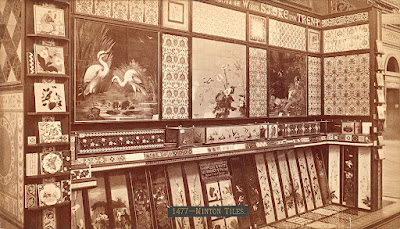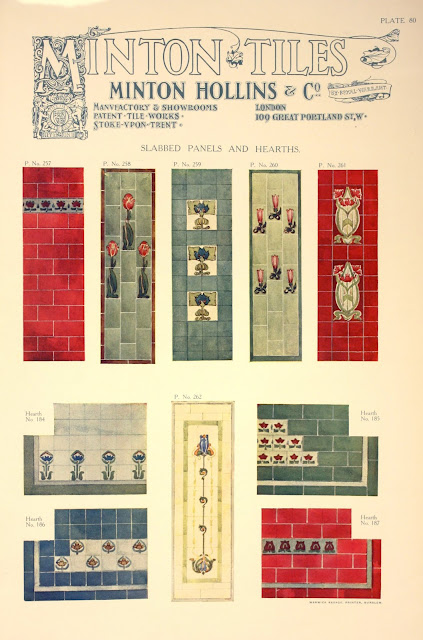Minton first showed majolica tiles at the great 1851 Crystal Palace Exposition. There, at the Mediaevil Court they furnished the tiles for the great stove of John Hartman & Co. Designed by Augustus Pugin, they caused a sensation. After Pugin’s death the following year they continued manufacturing tiles in the gothic style as well as many others.
John Hardman & Co stove at the 1851 Crystal Palace Exposition
Minton produced tiles under a number of different names including: Minton & Co.(floor tiles until 1868 then wall tiles), Minton, Hollins & Co. (wall tiles), Mintons Ltd. The tile factory was separately housed from the pottery factory run by two of Minton's nephews, Michael Daintry Hollins and Colin Minton Campbell.
Minton-Hollins tile display at the 1876 Philadelphia Exposition.
The history of the tile works is a complex one with acrimony arising between the two cousins after 1868 when the tile business split from the pottery entirely with one cousin maintaining ownership of the tiles works and one the pottery. Ownership of the Minton name was battled over for years until Campbell's death in 1887. At this point a third relative entered the fray, Robert Minton Taylor who maintained production of tile works under several names, including his own until 1963.
Still, it is the majolica tiles manufactured before Campbell's death that are those most sought by collectors. They can basically be divided into three types: traditional three-dimensional or sculptural majolica, called “embossed” by the company; tube-lined majolica; and pictorial majolica. A fourth type of majolica tile--those monochromatic tiles with transfer or hand painted decoration--aren't included here because they lack high relief, the three-dimensional quality that makes victorian majolica as popular as it is.
For the same reason that majolica was never used for dinnerware, decorative majolica tiles were deemed to be too soft to hold up to the rigors of daily use as floor tiles. Most majolica tiles were instead used on walls and decorated surfaces while encaustic or dust pressed tiles were used for the elaborate floor decorations Victorians favored.
These tiles were almost always marked on the reverse with the Minton mark.
Reverse of Robert Minton Taylor tile
Traditional Victorian Majolica:Made in a number of different styles these tiles approximate the type of majolica processes that were then being used in Minton majolica pottery. These tiles have a deep three-dimensional field and are in quite a bit of demand by collectors. Some, like the corn tile, bring many hundreds of dollars in the marketplace.
The most commonly found majolica tiles are the tube lined tiles. Tube Lined has a raised clay outline applied with the areas in between filled with majolica glazes, much like cloisonnė or like a coloring book. These are the most reasonably priced tiles available with huge quantities having been produced in the art nouveau style.
Minton majolica Prosser patent tile. Prosser tiles were made by a unique
dust-pressed process that differentiated them from conventional majolica tiles.
Pictorial Majolica
These tiles are sculptural in character with many of them representing historical events or mythological figures. These are generally monochromatic in color with high relief allowing the transparent quality of majolica glaze to accentuate detail through the pooling of glaze in the crevices of the design. Those with intricate modeling and desirable subjects usually bring high prices at auction though not generally as high as the traditional majolica tiles. The simpler ones were often used to break up large expanses of field tile by adding a simple decorative element without the addition of a second color. These are usually the least desirable of all Minton majolica tiles and sell quite inexpensively.
Design for tile by E, Welby Pugin
The Minton tile works sold many tiles through catalogs. Fortunately some of these have survived to give us a good idea of how they were used.
Buying Minton Tiles
Tile can be broken down into two basic types: decorative tile and field tile. Those that I've featured here are all decorative tile. Field tiles are those plain color tiles that make up the bulk of tiled surfaces.
As mentioned earlier, the majolica tiles that have 3-dimensional fields, the embossed tiles, and a great deal of color are those most in demand and those that command the highest prices, some commanding many hundreds of dollars. The tube lined tiles are the most common and as such can be found quite reasonably.
When buying tiles check the corners most of all. Many tiles are reclaimed; those salvaged from old buildings. These are most likely to have damage and should be carefully examined before buying. Some collectors do not mind buying tiles that have damage as long as it is in an area not visible from the front. Many tiles are also sold in frames. These too should be carefully examined in the back to check for repair before buying. Like any other type of majolica, tiles with repair will bring lower prices than those without.
If you would like to download a PDF of the 1909 Minton Tiles Pattern Book go here.
















































































































